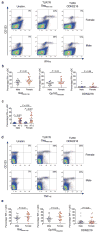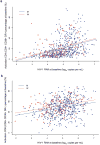Sex differences in the Toll-like receptor-mediated response of plasmacytoid dendritic cells to HIV-1
- PMID: 19597505
- PMCID: PMC2821111
- DOI: 10.1038/nm.2004
Sex differences in the Toll-like receptor-mediated response of plasmacytoid dendritic cells to HIV-1
Abstract
Manifestations of viral infections can differ between women and men, and marked sex differences have been described in the course of HIV-1 disease. HIV-1-infected women tend to have lower viral loads early in HIV-1 infection but progress faster to AIDS for a given viral load than men. Here we show substantial sex differences in the response of plasmacytoid dendritic cells (pDCs) to HIV-1. pDCs derived from women produce markedly more interferon-alpha (IFN-alpha) in response to HIV-1-encoded Toll-like receptor 7 (TLR7) ligands than pDCs derived from men, resulting in stronger secondary activation of CD8(+) T cells. In line with these in vitro studies, treatment-naive women chronically infected with HIV-1 had considerably higher levels of CD8(+) T cell activation than men after adjusting for viral load. These data show that sex differences in TLR-mediated activation of pDCs may account for higher immune activation in women compared to men at a given HIV-1 viral load and provide a mechanism by which the same level of viral replication might result in faster HIV-1 disease progression in women compared to men. Modulation of the TLR7 pathway in pDCs may therefore represent a new approach to reduce HIV-1-associated pathology.
Figures




Comment in
-
HIV gender clues emerge.Nat Med. 2009 Aug;15(8):830. doi: 10.1038/nm0809-830b. Nat Med. 2009. PMID: 19661976 No abstract available.
-
Plasmacytoid dendritic cells, Janus-faced sentinels: progesterone, guilty or innocent?Immunotherapy. 2009 Nov;1(6):929-31. doi: 10.2217/imt.09.71. Immunotherapy. 2009. PMID: 20635911
Similar articles
-
Sex Differences in Primary HIV Infection: Revisiting the Role of TLR7-Driven Type 1 IFN Production by Plasmacytoid Dendritic Cells in Women.Front Immunol. 2021 Aug 27;12:729233. doi: 10.3389/fimmu.2021.729233. eCollection 2021. Front Immunol. 2021. PMID: 34512664 Free PMC article. Review.
-
Toll-like receptor 7-adapter complex modulates interferon-α production in HIV-stimulated plasmacytoid dendritic cells.PLoS One. 2019 Dec 12;14(12):e0225806. doi: 10.1371/journal.pone.0225806. eCollection 2019. PLoS One. 2019. PMID: 31830058 Free PMC article.
-
Plasmacytoid dendritic cell number and responses to Toll-like receptor 7 and 9 agonists vary in HIV Type 1-infected individuals in relation to clinical state.AIDS Res Hum Retroviruses. 2013 Mar;29(3):501-10. doi: 10.1089/aid.2012.0200. Epub 2013 Jan 15. AIDS Res Hum Retroviruses. 2013. PMID: 23131038 Free PMC article.
-
Plasmacytoid dendritic cells express TRAIL and induce CD4+ T-cell apoptosis in HIV-1 viremic patients.Blood. 2009 Oct 29;114(18):3854-63. doi: 10.1182/blood-2009-04-217927. Epub 2009 Aug 18. Blood. 2009. PMID: 19690337
-
The involvement of plasmacytoid cells in HIV infection and pathogenesis.Cytokine Growth Factor Rev. 2018 Apr;40:77-89. doi: 10.1016/j.cytogfr.2018.03.009. Epub 2018 Mar 21. Cytokine Growth Factor Rev. 2018. PMID: 29588163 Review.
Cited by
-
Mechanisms of long COVID and the path toward therapeutics.Cell. 2024 Oct 3;187(20):5500-5529. doi: 10.1016/j.cell.2024.07.054. Epub 2024 Sep 25. Cell. 2024. PMID: 39326415 Review.
-
The impact of sex on HIV immunopathogenesis and therapeutic interventions.J Clin Invest. 2024 Sep 17;134(18):e180075. doi: 10.1172/JCI180075. J Clin Invest. 2024. PMID: 39286972 Free PMC article. Review.
-
Differences in HIV-1 reservoir size, landscape characteristics and decay dynamics in acute and chronic treated HIV-1 Clade C infection.medRxiv [Preprint]. 2024 Oct 9:2024.02.16.24302713. doi: 10.1101/2024.02.16.24302713. medRxiv. 2024. PMID: 38947072 Free PMC article. Preprint.
-
Sustained aviremia despite anti-retroviral therapy non-adherence in male children after in utero HIV transmission.Nat Med. 2024 Oct;30(10):2796-2804. doi: 10.1038/s41591-024-03105-4. Epub 2024 Jun 6. Nat Med. 2024. PMID: 38843818 Free PMC article.
-
The role of plasmacytoid dendritic cells (pDCs) in immunity during viral infections and beyond.Cell Mol Immunol. 2024 Sep;21(9):1008-1035. doi: 10.1038/s41423-024-01167-5. Epub 2024 May 22. Cell Mol Immunol. 2024. PMID: 38777879 Free PMC article. Review.
References
-
- Katzenstein DA, et al. The relation of virologic and immunologic markers to clinical outcomes after nucleoside therapy in HIV-infected adults with 200 to 500 CD4 cells per cubic millimeter. AIDS Clinical Trials Group Study 175 Virology Study Team. N Engl J Med. 1996;335:1091–8. - PubMed
-
- Farzadegan H, et al. Sex differences in HIV-1 viral load and progression to AIDS. Lancet. 1998;352:1510–4. - PubMed
-
- Evans JS, et al. Serum levels of virus burden in early-stage human immunodeficiency virus type 1 disease in women. J Infect Dis. 1997;175:795–800. - PubMed
-
- Sterling TR, et al. Sex differences in longitudinal human immunodeficiency virus type 1 RNA levels among seroconverters. J Infect Dis. 1999;180:666–72. - PubMed
Publication types
MeSH terms
Substances
Grants and funding
- R21 AI071806-01A2/AI/NIAID NIH HHS/United States
- R21 AI071806/AI/NIAID NIH HHS/United States
- AI25879/AI/NIAID NIH HHS/United States
- U01 AI038858/AI/NIAID NIH HHS/United States
- U01 AI027666/AI/NIAID NIH HHS/United States
- AI27659/AI/NIAID NIH HHS/United States
- AI38855/AI/NIAID NIH HHS/United States
- U01 AI027659/AI/NIAID NIH HHS/United States
- P01 AI074415-01A20001/AI/NIAID NIH HHS/United States
- K01 AI062435/AI/NIAID NIH HHS/United States
- AI27666/AI/NIAID NIH HHS/United States
- AI38858/AI/NIAID NIH HHS/United States
- U01 AI038855/AI/NIAID NIH HHS/United States
- P01 AI074415-01A2/AI/NIAID NIH HHS/United States
- P01 AI074415/AI/NIAID NIH HHS/United States
- HHSN261200800001C/CA/NCI NIH HHS/United States
- K01AI062435/AI/NIAID NIH HHS/United States
- R21 AI071806-02/AI/NIAID NIH HHS/United States
- HHSN261200800001E/CA/NCI NIH HHS/United States
- U01 AI025879/AI/NIAID NIH HHS/United States
LinkOut - more resources
Full Text Sources
Other Literature Sources
Medical
Molecular Biology Databases
Research Materials

